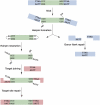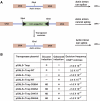piggyBac can bypass DNA synthesis during cut and paste transposition
- PMID: 18354502
- PMCID: PMC2323262
- DOI: 10.1038/emboj.2008.41
piggyBac can bypass DNA synthesis during cut and paste transposition
Abstract
DNA synthesis is considered a defining feature in the movement of transposable elements. In determining the mechanism of piggyBac transposition, an insect transposon that is being increasingly used for genome manipulation in a variety of systems including mammalian cells, we have found that DNA synthesis can be avoided during piggyBac transposition, both at the donor site following transposon excision and at the insertion site following transposon integration. We demonstrate that piggyBac transposon excision occurs through the formation of transient hairpins on the transposon ends and that piggyBac target joining occurs by the direct attack of the 3'OH transposon ends on to the target DNA. This is the same strategy for target joining used by the members of DDE superfamily of transposases and retroviral integrases. Analysis of mutant piggyBac transposases in vitro and in vivo using a piggyBac transposition system we have established in Saccharomyces cerevisiae suggests that piggyBac transposase is a member of the DDE superfamily of recombinases, an unanticipated result because of the lack of sequence similarity between piggyBac and DDE family of recombinases.
Figures








Similar articles
-
PLE-wu, a new member of piggyBac transposon family from insect, is active in mammalian cells.J Biosci Bioeng. 2014 Oct;118(4):359-66. doi: 10.1016/j.jbiosc.2014.03.010. Epub 2014 Apr 21. J Biosci Bioeng. 2014. PMID: 24751435
-
A hyperactive piggyBac transposase for mammalian applications.Proc Natl Acad Sci U S A. 2011 Jan 25;108(4):1531-6. doi: 10.1073/pnas.1008322108. Epub 2011 Jan 4. Proc Natl Acad Sci U S A. 2011. PMID: 21205896 Free PMC article.
-
Dimerization through the RING-Finger Domain Attenuates Excision Activity of the piggyBac Transposase.Biochemistry. 2018 May 22;57(20):2913-2922. doi: 10.1021/acs.biochem.7b01191. Epub 2018 May 11. Biochemistry. 2018. PMID: 29750515
-
Tn5 as a model for understanding DNA transposition.Mol Microbiol. 2003 Mar;47(5):1199-206. doi: 10.1046/j.1365-2958.2003.03382.x. Mol Microbiol. 2003. PMID: 12603728 Review.
-
piggyBac Transposon.Microbiol Spectr. 2015 Apr;3(2):MDNA3-0028-2014. doi: 10.1128/microbiolspec.MDNA3-0028-2014. Microbiol Spectr. 2015. PMID: 26104701 Review.
Cited by
-
An efficient strategy for producing a stable, replaceable, highly efficient transgene expression system in silkworm, Bombyx mori.Sci Rep. 2015 Mar 5;5:8802. doi: 10.1038/srep08802. Sci Rep. 2015. PMID: 25739894 Free PMC article.
-
Structural basis of seamless excision and specific targeting by piggyBac transposase.Nat Commun. 2020 Jul 10;11(1):3446. doi: 10.1038/s41467-020-17128-1. Nat Commun. 2020. PMID: 32651359 Free PMC article.
-
What role (if any) does the highly conserved CSB-PGBD3 fusion protein play in Cockayne syndrome?Mech Ageing Dev. 2013 May-Jun;134(5-6):225-33. doi: 10.1016/j.mad.2013.01.001. Epub 2013 Jan 28. Mech Ageing Dev. 2013. PMID: 23369858 Free PMC article. Review.
-
Functional Characterization of the N-Terminal Disordered Region of the piggyBac Transposase.Int J Mol Sci. 2022 Sep 7;23(18):10317. doi: 10.3390/ijms231810317. Int J Mol Sci. 2022. PMID: 36142241 Free PMC article.
-
PiggyMac, a domesticated piggyBac transposase involved in programmed genome rearrangements in the ciliate Paramecium tetraurelia.Genes Dev. 2009 Nov 1;23(21):2478-83. doi: 10.1101/gad.547309. Genes Dev. 2009. PMID: 19884254 Free PMC article.
References
Publication types
MeSH terms
Substances
Grants and funding
LinkOut - more resources
Full Text Sources
Other Literature Sources
Research Materials

